Growing Green
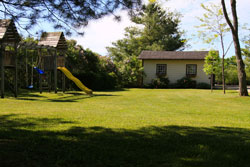 Some things in life are as simple as they look, but fertilizing your lawn and garden properly isn’t one of them. That’s because there’s more than meets the eye when it comes to providing the right kind of plant nutrients in the right quantities and in environmentally responsible ways. Doing things right isn’t complicated when you understand the basics, and success begins with knowledge that was discovered because of something unusual that happened in Indonesia in April 1815.
Some things in life are as simple as they look, but fertilizing your lawn and garden properly isn’t one of them. That’s because there’s more than meets the eye when it comes to providing the right kind of plant nutrients in the right quantities and in environmentally responsible ways. Doing things right isn’t complicated when you understand the basics, and success begins with knowledge that was discovered because of something unusual that happened in Indonesia in April 1815.
That’s when Mount Tambora erupted, triggering world-wide cold temperatures that caused the worst international famine of modern times. In July and August 1816, for instance, lakes and rivers still had ice on them as far south as Pennsylvania. Twelve inches of snow fell in Quebec City in June. As looting of grain warehouses and starvation gripped Europe, a 13 year old boy from Germany named Justus von Liebig took it all in. His first-hand experience with famine led to a career as a scientist and a devotion to do everything he could to make food plentiful. The ground-breaking discoveries that Liebig identified form the foundation for fertilizer science that we still rely on today, including the work of making your lawn and garden green and productive.
Liebig’s main contribution to our understanding of plant growth was the fact that all plants need three main nutrients:
- Nitrogen
- Phosphorous
- Potassium
 These are abbreviated by their chemical symbols N-P-K, and they’re related to the analysis numbers you’ll find on bags and boxes of all legitimate fertilizer products. A bag of 10-10-10 fertilizer, for instance, contains 10% nitrogen, 10% phosphorous, and 10% potassium. Many lawn fertilizers are marked 24-0-3, meaning that 24% of the product is nitrogen, there’s no phosphorus and there’s 3% potassium.
These are abbreviated by their chemical symbols N-P-K, and they’re related to the analysis numbers you’ll find on bags and boxes of all legitimate fertilizer products. A bag of 10-10-10 fertilizer, for instance, contains 10% nitrogen, 10% phosphorous, and 10% potassium. Many lawn fertilizers are marked 24-0-3, meaning that 24% of the product is nitrogen, there’s no phosphorus and there’s 3% potassium.
The first thing to understand about optimal fertilizer use is that every lawn and garden situation is unique. Soils vary in their composition. Nutrient levels can be generally high, low or even imbalanced in relation to each other. Soils that had good fertility levels last year, could be low now.
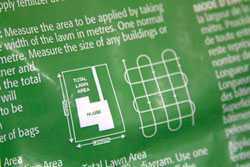 All this is why it makes sense to begin by having samples of your soil checked out in a lab. The process is fast, easy and costs about $20. Soil testing tells you more than just the state of nutrient levels you’ve got. A good analysis tells you how much fertilizer is ideal and what kind is best depending on what you plan to grow. The nutrient requirements of ornamental bushes, for instance, are different than if you’re growing vegetables. Flowering plants actually require less nitrogen than a lawn if you expect to get blooms.
All this is why it makes sense to begin by having samples of your soil checked out in a lab. The process is fast, easy and costs about $20. Soil testing tells you more than just the state of nutrient levels you’ve got. A good analysis tells you how much fertilizer is ideal and what kind is best depending on what you plan to grow. The nutrient requirements of ornamental bushes, for instance, are different than if you’re growing vegetables. Flowering plants actually require less nitrogen than a lawn if you expect to get blooms.
With some sense of the nutrients your soil is short of, the next step is to figure out how much area you need to cover. If you’re fertilizing your lawn, multiply the length and width of your lot, then subtract the area taken up by your house, driveway, walkways and decks. Eventually all this boils down to something quite simple. You’ll have a certain number of fertilizer bags sitting in the trunk of your car, along with the challenge of getting it spread evenly over the grass. This is where you need a little mechanical help.
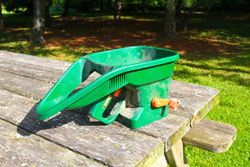
Before you go any farther, you need to realize that no matter how careful you are, it’s virtually impossible to apply granular fertilizer to a lawn properly by hand. That’s because it’s so easy to put on way too much in some places, and way too little in another. Spreading by hand takes much longer than necessary, too. You can sprinkle a little around individual shrubs and trees, but lawns are different. Lawns are why fertilizer spreaders were invented.
You’ll find small, hand-held crank models for use on tiny lawns, or larger, rolling models for bigger areas. You can also rent fertilizer spreaders, but for all they cost, you might as well buy your own and save the driving. Regardless of what you choose, spreaders are designed to evenly meter out granulated fertilizer at whatever rate you set them to. And there’s a trick for calibrating any spreader that helps every time.
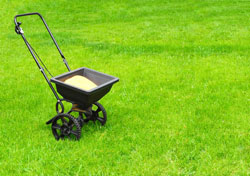 Fertilizer spreaders can be easy to adjust or not so easy, depending on how they’re designed. Most fertilizer bags include instructions for adjusting your spreader, so be sure you read. Experience will also show you what setting is ideal for spreading X number of bags on Y square feet of lawn. If in doubt, err on the side of calibrating your spreader so it delivers less fertilizer than needed on the first pass. You can always make additional passes to get the coverage you need. Adjust the delivery rate up as needed until you get a feel for the settings required to deliver the right quantity of fertilizer over the area you’ve got.
Fertilizer spreaders can be easy to adjust or not so easy, depending on how they’re designed. Most fertilizer bags include instructions for adjusting your spreader, so be sure you read. Experience will also show you what setting is ideal for spreading X number of bags on Y square feet of lawn. If in doubt, err on the side of calibrating your spreader so it delivers less fertilizer than needed on the first pass. You can always make additional passes to get the coverage you need. Adjust the delivery rate up as needed until you get a feel for the settings required to deliver the right quantity of fertilizer over the area you’ve got.
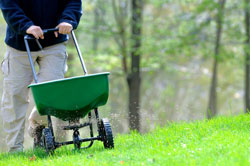 When properly applied at outdoor temperatures lower than 30ºC, granular fertilizer won’t burn your grass regardless of whether it rains or you water right away or not. That said, it makes sense to wait until granulated fertilizer has dissolved before mowing. You don’t want to blow the granules all over the place with the lawn mower. No need to worry about kids and pets walking on the grass immediately after fertilizer application. It’s safe. The only reason to keep them off at first is to stop them from tracking fertilizer granules into the house.
When properly applied at outdoor temperatures lower than 30ºC, granular fertilizer won’t burn your grass regardless of whether it rains or you water right away or not. That said, it makes sense to wait until granulated fertilizer has dissolved before mowing. You don’t want to blow the granules all over the place with the lawn mower. No need to worry about kids and pets walking on the grass immediately after fertilizer application. It’s safe. The only reason to keep them off at first is to stop them from tracking fertilizer granules into the house.
Determine what nutrients your soil needs, calculate how much fertilizer is required to deliver them, then distribute the product evenly at the right rate. These are the simple, yet often overlooked steps to optimal lawn and garden care. Do things right and you’ll save time, money and gain a lush, healthy yard.